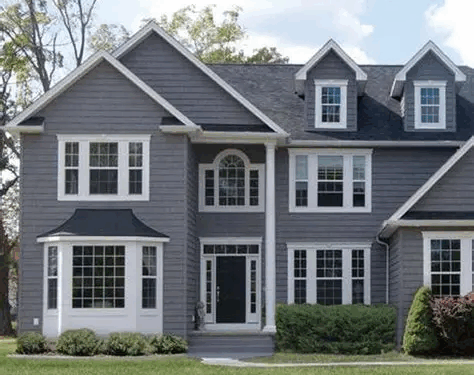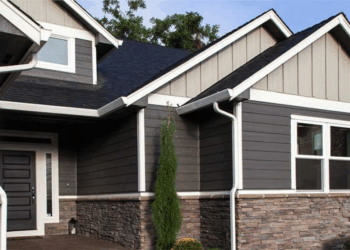
Embark on a journey through the realm of vinyl exterior house, where durability meets style and low maintenance reigns supreme. Discover the vibrant colors, versatile styles, and countless benefits that vinyl siding has to offer.
From the installation process to cost considerations and maintenance tips, this comprehensive guide will equip you with everything you need to know about vinyl exterior house.
Benefits of Vinyl Exterior House
Vinyl siding is a popular choice for exterior house cladding due to its numerous benefits.
Durability of Vinyl Siding
Vinyl siding is known for its durability, as it can withstand harsh weather conditions such as strong winds, heavy rain, and extreme temperatures without warping, cracking, or fading.
Low Maintenance
Compared to other materials like wood or brick, vinyl siding requires minimal maintenance. It does not need to be repainted and can be easily cleaned with a hose and mild soap, saving homeowners time and money in the long run.
Variety of Colors and Styles
One of the advantages of vinyl siding is the wide range of colors and styles available. Homeowners can choose from different textures, profiles, and finishes to achieve the desired look for their home, making it a versatile option for any architectural style.
Installation of Vinyl Exterior House
Installing vinyl siding involves several steps to ensure a successful and durable exterior for your home. Let's take a look at the process, tools, materials, and considerations involved in installing vinyl siding.
Steps Involved in Installing Vinyl Siding
- Prepare the surface: Ensure the exterior of the house is clean, smooth, and free of any debris or damage.
- Measure and cut the siding: Accurately measure each section of the house where vinyl siding will be installed and cut the panels accordingly.
- Install the starter strip: Begin by installing a starter strip at the bottom of the wall to provide a secure base for the siding.
- Hang the siding panels: Start at one end of the wall and work your way across, overlapping the panels to create a seamless look.
- Finish with trim pieces: Complete the installation by adding trim pieces around windows, doors, and corners for a polished appearance.
Tools and Materials Needed for a Successful Installation
- Vinyl siding panels
- Starter strip
- Nails or screws
- J-channel
- Trim pieces
- Utility knife
- Tin snips
- Tape measure
- Level
- Caulk gun
Special Considerations and Challenges
- Weather conditions: Extreme temperatures or high winds can impact the installation process, so it's important to choose the right time for installation.
- Proper alignment: Ensuring the siding panels are properly aligned and leveled is crucial for a professional-looking finish.
- Moisture protection: Properly sealing seams and joints is essential to prevent water infiltration and damage to the house structure.
Cost Considerations for Vinyl Exterior House
When considering vinyl siding for your home's exterior, it is essential to take into account the cost implications. Understanding how vinyl siding compares to other materials, what factors can impact installation costs, and how to save money on vinyl siding projects can help you make informed decisions.
Comparing the Cost of Vinyl Siding to Other Exterior Materials
When comparing the cost of vinyl siding to other exterior materials such as wood, brick, or stucco, vinyl siding tends to be more cost-effective. Vinyl siding is generally less expensive to purchase and install compared to these other materials, making it a popular choice for homeowners looking to improve their home's curb appeal on a budget.
Factors Impacting the Cost of Vinyl Siding Installation
- The size of your home: Larger homes will require more materials and labor, increasing the overall cost of vinyl siding installation.
- The quality of the vinyl siding: Higher-quality vinyl siding may cost more upfront but can result in lower maintenance costs over time.
- Additional features: Adding features such as insulation, trim details, or decorative elements can increase the cost of vinyl siding installation.
- Local labor costs: Labor costs can vary depending on your location, impacting the total cost of vinyl siding installation.
Tips to Save Money on Vinyl Siding Projects
- Compare quotes from multiple contractors to ensure you are getting a competitive price for your vinyl siding project.
- Consider purchasing mid-grade vinyl siding that offers a good balance between cost and quality.
- Do some of the prep work yourself, such as removing old siding or clearing the work area, to reduce labor costs.
- Opt for standard colors and styles of vinyl siding, as custom options can be more expensive.
Maintenance and Care of Vinyl Exterior House
Proper maintenance and care are essential to ensure the longevity and appearance of vinyl siding. By following a recommended routine and addressing common issues promptly, you can keep your vinyl exterior house looking great for years to come.
Recommended Maintenance Routine
- Inspect the siding regularly for any signs of damage, such as cracks, holes, or warping.
- Clean the siding at least once a year using a mixture of water and mild detergent. Avoid using harsh chemicals or abrasive cleaners.
- Trim any vegetation around the house to prevent it from coming into contact with the siding and causing damage.
- Check the caulking around windows, doors, and other openings to ensure a tight seal and prevent water infiltration.
Cleaning and Preserving Vinyl Siding
Regular cleaning is key to preserving the appearance of vinyl siding. Here's how you can clean and maintain your vinyl exterior house:
- Use a soft brush or cloth to scrub the siding gently, starting from the bottom and working your way up.
- Rinse the siding thoroughly with a garden hose to remove any dirt and soap residue.
- For tough stains, you can use a solution of vinegar and water or a specialized vinyl siding cleaner.
- Avoid using high-pressure washers, as they can damage the siding and void the warranty.
Addressing Common Issues or Damage
Despite proper maintenance, vinyl siding may still encounter issues or damage. Here's how you can address common problems:
- For small cracks or holes, use caulk to seal the damaged area and prevent water infiltration.
- If a section of siding is warped or loose, carefully remove it and replace it with a new piece of siding.
- Mold and mildew can be removed using a solution of bleach and water, followed by a thorough rinse.
- If you notice fading or discoloration, consider painting the siding with a vinyl-safe paint to refresh its appearance.
Final Conclusion
As we wrap up our exploration of vinyl exterior house, remember that this versatile material not only enhances the aesthetics of your home but also stands the test of time with its durability and easy upkeep. Whether you're considering a new installation or looking to spruce up your existing vinyl siding, the possibilities are endless in creating a beautiful and functional exterior for your home.
FAQ Section
What makes vinyl siding a popular choice for exterior house cladding?
Vinyl siding is known for its durability, low maintenance requirements, and wide range of colors and styles, making it a versatile and cost-effective option for homeowners.
Can vinyl siding be painted to change the color?
While it's possible to paint vinyl siding, it's generally not recommended as the paint may not adhere well to the surface and could result in peeling or fading over time.
How often should vinyl siding be cleaned?
It's recommended to clean vinyl siding at least once a year using a mixture of mild soap and water to maintain its appearance and remove any dirt or grime buildup.
What are some common issues that may arise with vinyl siding?
Common issues with vinyl siding include fading, warping, or cracking, which can be addressed through proper maintenance and timely repairs to ensure the longevity of the material.











